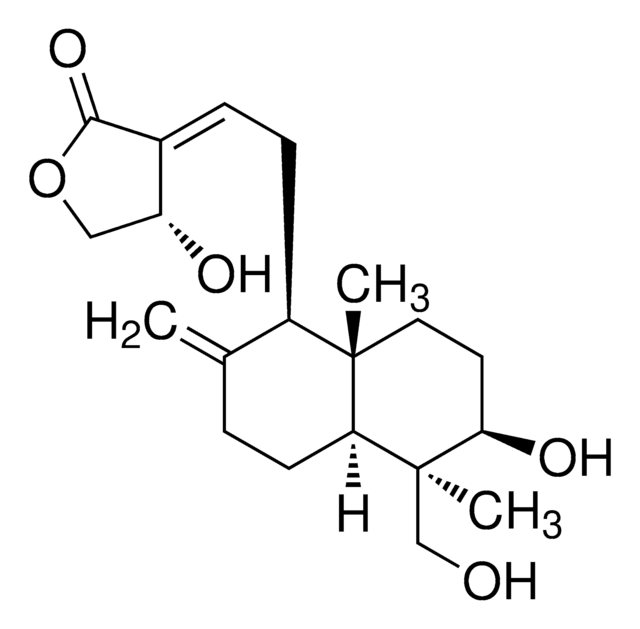W382108
3-Carene
≥90%
Synonim(y):
δ3-Carene, 3,7,7-Trimethylbicyclo[4.1.0]hept-3-ene
About This Item
Polecane produkty
pochodzenie biologiczne
synthetic
Próba
≥90%
współczynnik refrakcji
n20/D 1.474 (lit.)
tw
168-169 °C/705 mmHg (lit.)
gęstość
0.857 g/mL at 25 °C (lit.)
Zastosowanie
flavors and fragrances
Dokumentacja
see Safety & Documentation for available documents
alergen pokarmowy
no known allergens
Organoleptyczne
citrus; sweet
ciąg SMILES
CC1=CCC2C(C1)C2(C)C
InChI
1S/C10H16/c1-7-4-5-8-9(6-7)10(8,2)3/h4,8-9H,5-6H2,1-3H3
Klucz InChI
BQOFWKZOCNGFEC-UHFFFAOYSA-N
Szukasz podobnych produktów? Odwiedź Przewodnik dotyczący porównywania produktów
Powiązane kategorie
Opis ogólny
Zastosowanie
- Identification and quality evaluation of Lushan Yunwu tea from different geographical origins based on metabolomics.: The presence of 3-carene in Lushan Yunwu tea is studied for its impact on tea quality and flavor profile, providing insights into the metabolomic distinctions influenced by geographical factors (Sun et al., 2024).
- Influence of Maqian essential oil on gut microbiota and immunoresponses in type 1 diabetes: In silico study.: This in silico study investigates how 3-carene, as a component of Maqian essential oil, influences the gut microbiota and immune responses in type 1 diabetes, suggesting potential therapeutic uses of 3-carene in managing autoimmune diseases (Dahab et al., 2024).
Oświadczenie o zrzeczeniu się odpowiedzialności
Hasło ostrzegawcze
Danger
Zwroty wskazujące rodzaj zagrożenia
Zwroty wskazujące środki ostrożności
Klasyfikacja zagrożeń
Aquatic Chronic 3 - Asp. Tox. 1 - Flam. Liq. 3 - Skin Irrit. 2 - Skin Sens. 1
Kod klasy składowania
3 - Flammable liquids
Klasa zagrożenia wodnego (WGK)
WGK 2
Temperatura zapłonu (°F)
116.6 °F - closed cup
Temperatura zapłonu (°C)
47 °C - closed cup
Środki ochrony indywidualnej
Eyeshields, Faceshields, Gloves, type ABEK (EN14387) respirator filter
Certyfikaty analizy (CoA)
Poszukaj Certyfikaty analizy (CoA), wpisując numer partii/serii produktów. Numery serii i partii można znaleźć na etykiecie produktu po słowach „seria” lub „partia”.
Masz już ten produkt?
Dokumenty związane z niedawno zakupionymi produktami zostały zamieszczone w Bibliotece dokumentów.
Klienci oglądali również te produkty
Protokoły
GC Analysis of Sweet Orange Essential Oil on SLB®-5ms (10 m x 0.10 mm I.D., 0.10 μm), Fast GC Analysis
Nasz zespół naukowców ma doświadczenie we wszystkich obszarach badań, w tym w naukach przyrodniczych, materiałoznawstwie, syntezie chemicznej, chromatografii, analityce i wielu innych dziedzinach.
Skontaktuj się z zespołem ds. pomocy technicznej















